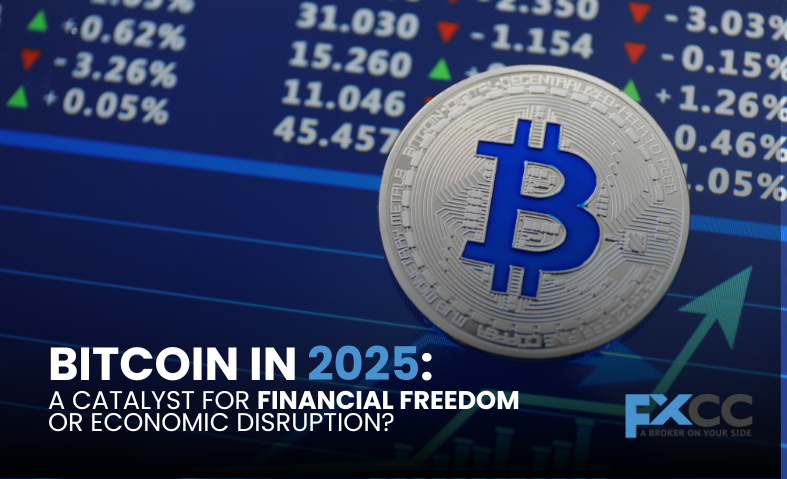The year 2025 finds Bitcoin at a fascinating crossroads, its decade-and-a-half journey marked by soaring valuations, regulatory scrutiny, and a persistent debate about its fundamental role in the global financial landscape. Will this year be the one where Bitcoin truly empowers individuals with financial freedom, or will its inherent volatility and decentralized nature lead to significant economic disruption? The answer, as always with Bitcoin, is complex and multifaceted.

Bitcoin as a Symbol of Economic Empowerment
Supporters of Bitcoin envision a world where people gain independence from conventional banking and financial institutions. Several factors support this optimistic view as we move through 2025:
- Decentralization and Autonomy: Bitcoin’s core tenet remains its decentralized nature. Unlike fiat currencies controlled by central banks and governments, Bitcoin operates on a peer-to-peer network, granting users full control over their funds. This eliminates the need for intermediaries, potentially reducing transaction costs and increasing efficiency, particularly for cross-border payments. In a world where trust in traditional institutions can waver, Bitcoin offers an alternative where individuals are their own banks.
- Inflation Hedge and Store of Value: With fiat currencies susceptible to inflationary pressures, Bitcoin’s fixed supply (capped at 21 million coins) is seen by many as a hedge against the erosion of purchasing power. In 2025, as global economic uncertainties persist, this characteristic could further solidify Bitcoin’s appeal as a store of value, similar to gold but with the added benefits of digital portability and divisibility.
- Financial Inclusion: Bitcoin has the potential to bring financial services to the unbanked and underbanked populations worldwide. With just a smartphone and internet access, individuals can participate in the global economy, bypassing the barriers of traditional banking systems. This inclusivity can foster economic empowerment and create new opportunities for individuals in developing regions.
- Growing Institutional Adoption: The increasing acceptance of Bitcoin by institutional investors signals a maturing asset class. The introduction of Bitcoin ETFs has further simplified access for retail investors and legitimized Bitcoin within mainstream finance. This trend is expected to continue in 2025, potentially driving further adoption and price appreciation.
- Technological Advancements: The underlying blockchain technology continues to evolve, with innovations like the Lightning Network offering faster and cheaper Bitcoin transactions. These advancements enhance Bitcoin’s usability and address some of its earlier limitations regarding scalability.
The Bear Case: Bitcoin as a Source of Economic Disruption
Despite the compelling arguments for Bitcoin’s role in financial freedom, concerns about its potential for economic disruption remain valid in 2025:
- Price Volatility: Bitcoin’s notorious price swings remain a significant hurdle for widespread adoption as a medium of exchange and a reliable store of value. The market can be influenced by a variety of factors, including regulatory announcements, macroeconomic trends, and even social media sentiment, leading to significant and often unpredictable price fluctuations. Due to its unpredictable price swings, Bitcoin poses challenges for routine spending and secure long-term saving.
- Regulatory Uncertainty: The regulatory landscape for Bitcoin remains fragmented and uncertain across different jurisdictions. While some countries are adopting a more welcoming stance, others maintain a cautious or even prohibitive approach. Inconsistent or restrictive regulations could stifle innovation and hinder Bitcoin’s mainstream adoption.
- Environmental Concerns: Bitcoin’s energy-intensive proof-of-work consensus mechanism has raised significant environmental concerns. While efforts are underway to transition to more sustainable alternatives, the high energy consumption remains a point of criticism and could lead to increased regulatory pressure or a negative public perception.
- Potential for Illicit Use: The pseudonymous nature of Bitcoin transactions has historically made it a preferred tool for illicit activities, although blockchain analysis tools are becoming increasingly sophisticated in tracking such transactions. Nevertheless, the potential for misuse remains a concern for regulators and could impede broader acceptance.
- Risk of Cyber Threats: As a digital asset, Bitcoin is susceptible to cyberattacks, including hacking of exchanges and individual wallets. The irreversible nature of Bitcoin transactions means that stolen funds are often lost permanently, posing a risk to investors and users.
- Limited Scalability: While solutions like the Lightning Network are improving transaction speeds, the Bitcoin network’s capacity to handle a large volume of transactions still lags behind traditional payment systems. This scalability issue could become a bottleneck if Bitcoin achieves widespread adoption.

Looking Ahead: Navigating the Crossroads
In 2025, Bitcoin’s journey will likely be characterized by a continued tug-of-war between its potential to empower individuals and the risks associated with its decentralized and volatile nature. The interplay of technological advancements, evolving regulations, and broader macroeconomic conditions will ultimately shape its trajectory.
It is plausible that Bitcoin will continue to carve out a niche as a digital store of value and a tool for financial inclusion in specific contexts. However, its widespread adoption as a mainstream currency for everyday transactions remains a significant challenge due to its inherent volatility and scalability limitations.
Ultimately, whether Bitcoin becomes a true catalyst for financial freedom or a source of economic disruption in 2025 and beyond will depend on how these challenges are addressed and how the global regulatory landscape evolves. It is a technology with immense potential, but its path forward is far from certain. As we navigate this pivotal year, a balanced perspective, acknowledging both the opportunities and the risks, is crucial to understanding Bitcoin’s evolving role in the world.


